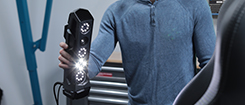September 20, 2024
Revolutionizing Custom Engine Fabrication with HandySCAN BLACK Elite & VXmodel See the articleThe automotive industry is undergoing a huge transformation. As the world moves towards more sustainable energy sources, electric vehicles (EVs) are becoming a driving force to transition from gas-powered cars. Just recently, Gear Patrol and Car and Driver have showcased future EVs from a wide range of automotive manufacturers, including Acura, Audi, Mercedes, Chevrolet, Ford, BMW, Polestar, Kia and Hyundai, just to name a few. Even luxury car brands, like Alfa Romeo, Maserati and Bentley, are jumping on the EV bandwagon.
What’s more, shops and the aftermarket sector are noticing a substantial increase in demand for converting combustion vehicles to electric, propelled by demand from DIYers and classic car collectors.
But developing EVs or converting traditional cars to electric is not a mere battery-swapping game. It’s a complex process involving precision, detail, and innovative engineering. At the heart of this new approach to vehicle design is 3D scanning technology.
We sat down with one of Creaform’s clients, Phiaro, to learn more about how the company is utilizing 3D scanners to convert conventional vehicles into EVs for its clients.
Based in Japan and with offices in Irvine, California, Phiaro is an industrial engineering company that offers research, design, and product development services to the automotive sector. In the business for over 80 years, the company has carved an enviable niche in the market for constantly pushing the technology envelope further.

Phiaro’s engineering managers see a promising future for Creaform’s 3D scanners in their EV design and inspection workflows
3D scanning: A pivotal technology for designing brand-new EVs
When manufacturers embark on a new project to create an innovative EV model, metrology-grade 3D scanners allow engineers and industrial designers to accurately acquire 3D measurements of existing combustion-engine vehicles, which can then be used as the springboard for designing its EV counterpart.
Traditional vehicle design methods, involving multiple physical prototypes and iterations, are both time-consuming and resource-intensive. Using 3D scanners can substantially reduce the costs associated with these EV development processes, making them more efficient and accelerating an automotive manufacturer’s time to market.
The design teams at Phiaro use Creaform’s Go!SCAN SPARK to replace their conventional methods of taking photographs with a digital camera or using legacy equipment fixed to a jig to conduct tests on the vehicles they are designing. Both of these methods were cumbersome as not all the information was readily available to Phiaro’s development teams or did not offer the level of accuracy required for engineering and performance assessments. The Go!SCAN SPARK generates measurements without the use of positioning targets which saves a lot of time, and it captures precise texture info together with color.
Combining the power of 3D scanning and mixed reality technologies
Always ahead of the curve when it comes to adopting new technologies, Phiaro is also using the Go!SCAN SPARK, along with mixed reality (MR) technologies, to recreate accurate virtual models of vehicles. These models, when integrated with mixed reality tools, provide a virtual playground for engineers. They can “explore” the car, “see” the components in 3D space, and virtually confirm the design of EV engines, for example, when they are installed in the actual vehicle space.
This virtual validation process drastically cuts down design and testing time. It also provides a tangible way for engineers across the globe to collaborate in real time. Imagine an engineer in Saitama working on a design and a colleague examining the outcomes in Tochigi, Japan, virtually walking around the same car model, providing instant feedback, and confirming changes.
Phiaro’s engineering managers see a promising future for Creaform’s 3D scanners in their EV design workflows. As many in the automotive industry know, the sector is just getting started when it comes to innovations in EV design and performance.
If you would like more information about how Creaform’s 3D measurement technologies can support your organization’s product development and quality control, contact one of our experts today.








